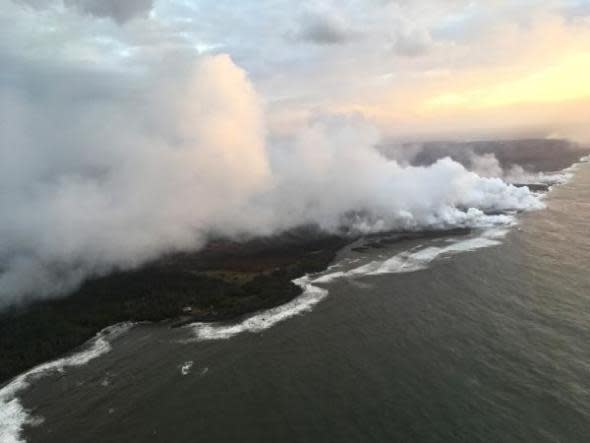Is Hawaii's Kīlauea volcano influencing locally excessive rainfall on the Big Island?
While it has long been known that volcanic eruptions can alter global climate patterns, less has been documented on the impacts of localized weather patterns following an increase in nearby activity.
The year of 1816, better known as the "Year Without a Summer," is one example of how global climate patterns were altered in the Northern Hemisphere following the explosive eruption of Indonesian volcano Mount Tambora one year earlier.
In recent months, The Big Island of Hawaii has seen an increased amount of volcanic activity from the mighty Kīlauea volcano. In addition, torrential downpours have also struck the island centered around the area of activity.
"Since the start of July, no fewer than three separate instances of very heavy rainfall have happened over a small area of southeastern Hawaii centered near a highly active lava vent," AccuWeather Senior Meteorologist Jim Andrews said.

Lava enters the ocean from Kīlauea. (Photo/USGS)
"Radar estimated rainfall, backed by actual rainfall data from two nearby cooperative weather observers, strongly tend to confirm that, indeed, torrential rainstorms have taken place," Andrews said, referring to Hawaii's recent storms. "These two sites have received rainfall of at least 25-30 inches within the first 10 days of the month."
"On at least two occasions, the local National Weather Service (NWS) office issued statements warning of high rainfall rates, owing to stationary heavy rain returns centered over or near the volcanic vent," Andrews said.
In 2010, dendrochronologists at Columbia University showed that large eruptions in the past altered rainfall patterns throughout Asia through their analysis of tree rings.
The team's research indicated much drier weather in central Asia during volcanic activity, while more rain tended to fall in southeastern Asia during the same period.
"We might think of the study of the solid earth and the atmosphere as two different things, but really everything in the system is interconnected," the study's lead author Kevin Anchukaitis said in a report published by Columbia University on the topic.
According to Andrews, many of the ingredients for seeding clouds and creating the conditions for heavy rain are present during volcanic venting.
The ingredients needed include heat, additional water vapor and potentially volcanic glass or ash particles.
"The lava contains dissolved gases," Andrews said, citing water vapor, sulfur dioxide and carbon dioxide as prime examples of being released by the volcanic vent in Hawaii.
"Much of this likely escapes at the vent, potentially yielding hundreds to thousands of cubic meters of burning hot gas, much of it water vapor," Andrews added.
It remains unknown whether volcanic venting may be increasing rainfall in the region. However, non-meteorological heat sources, such as forest fires, can create clouds.
"Towering cumuliform clouds triggered by a non-meteorological heat source, such as wildfires and volcanic eruptions, are known as pyrocumulus or pyrocumulonimbus," Andrews said.
According to retired United States Geological Survey (USGS) volcanologist Dr. Peter Ward, he has not heard of heavy rain being closely correlated to increased nearby volcanic activity and suspects Hawaii's local geography plays the primary role.
However, he did not rule out the possibility that volcanic gases could contribute to the ingredients needed to create storm systems.
"Water vapor is the most voluminous gas emitted by volcanoes and by basalt lava flows," Ward added.
In order to determine if there is any direct correlation between the volcanic venting and increased precipitation, regional rainfall patterns and local water sources would need to be assessed, he added.
According to Ward, the north side of Kīlauea is a rain forest while the south side is desert, stating that rainfall in the area is very localized.
In a study published in the Journal of Geophysical Research in 2013, research indicated that large volcanic eruptions can actually lead to reduced rainfall in a wide range of areas, while some trended wetter.
Columbia University researchers came to similar conclusions, seeing an overall drier trend in most areas following volcanic activity.
"Volcanoes can be important players in climate over time," Anchukaitis said in Columbia's report.
